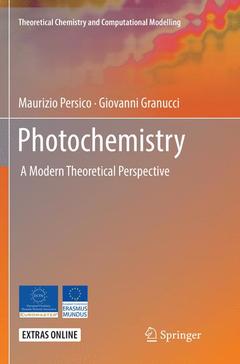Description
Photochemistry, Softcover reprint of the original 1st ed. 2018
A Modern Theoretical Perspective
Theoretical Chemistry and Computational Modelling Series
Language: English
Subjects for Photochemistry:
Photochemistry
Publication date: 01-2019
263 p. · 15.5x23.5 cm · Paperback
Publication date: 01-2019
263 p. · 15.5x23.5 cm · Paperback
Photochemistry
Publication date: 05-2018
Support: Print on demand
Publication date: 05-2018
Support: Print on demand
Description
/li>Contents
/li>Biography
/li>Comment
/li>
This book offers an introduction to photochemistry for students with a minimal background in physical chemistry and molecular quantum mechanics. The focus is from a theoretical perspective and highlights excited state dynamics. The authors, experienced lecturers, describe the main concepts in photochemical and photophysical processes that are used as a basis to interpret classical steady-state experimental results (essentially product branching ratios and quantum yields) and the most advanced time-resolved techniques. A significant portion of the content is devoted to the computational techniques present in quantum chemistry and molecular dynamics.
With its short summaries, questions and exercises, this book is aimed at graduate students, while its theoretical focus differentiates it from most introductory textbooks on photochemistry.
Chapter 1. Introduction.-What is photochemistry. -Primary and secondary processes, quantum yields.-Photochemical kinetics. Unimolecular and bimolecular processes.
.-Chapter 2. Molecular states.-The time-dependent Schrödinger equation.-Molecular dynamics and the separation of variables.-The Born-Oppenheimer approximation and its breakdown: the nonadiabatic couplings.-The electrostatic approximation: spin and magnetic couplings.-Vibrational and rotational states.-Electronic states of polyatomics and photoreactivity.-Environmental effects.-Computational note: the determination of electronic excited states.-Chapter 3. Electronic excitation and decay.-Perturbation theory and the time evolution of molecular states.-Light absorption and emission.-Light pulses and the excitation to non-stationary states.-Beyond perturbation theory.-Decay to a continuum or quasi-continuum of states: Fermi's golden rule.-Computational note: transition matrix elements.-Chapter 4. Fast nonadiabatic dynamics.-Non-crossing rule and avoided crossings.-Diabatic states.-Landau-Zener rule.-Conical intersections and other surface crossings.-Computational note: methods for nonadiabatic dynamics.-Chapter 5. Charge and energy transfer.-Localization of charge and excitation.-Charge transfer: Marcus theory.-Excitation transfer: Förster and Dexter mechanisms.-Excitonic coupling and antenna effect.-Spin changing processes.-Computational note: localization and couplings.-Chapter 6. Femtochemistry.-Time-resolved fluorescence.-Time-resolved differential absorption.-Time-resolved photoelectron spectroscopy.-Resonant Raman spectroscopy.-Computational note: the simulation of transient spectra.
Maurizio Persico received his Masters in Chemistry from the University of Pisa, Italy in 1976. He spent one year as a post-doc at the Freie Universität Berlin and was a Research Assistant at Scuola Normale Superiore from 1982 to 1987. In 1987 he became Associate Professor and in 2000 Full Professor, at the University of Pisa. His main research interest is in the theory and computational simulation of the dynamics of molecular excited states.
Giovanni Granucci graduated and obtained his Ph.D. from the University of Pisa in 1996. After postdoctoral work at the Ecole Normale Superieure and the CEA in Paris, he became a Research Assistant at the University of Pisa. His main research interest is in the computational study of molecular excited state dynamics. He is a co-author of circa 70 scientific publications.
Contains an in-depth explanation of molecular dynamics phenomena
Provides questions and exercises at the end of each chapter
Presents supplementary material that includes animations of molecular dynamics illustrating theoretical concepts
Includes short summaries on state-of-the-art computational methods used in research
© 2024 LAVOISIER S.A.S.




